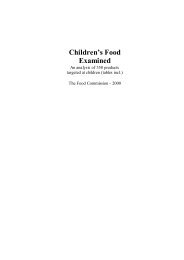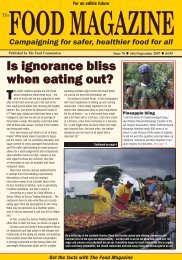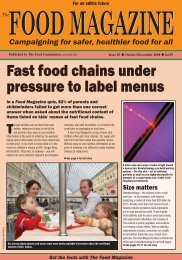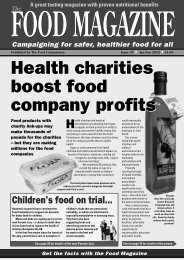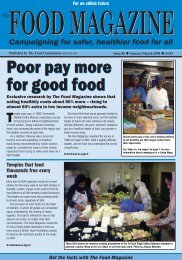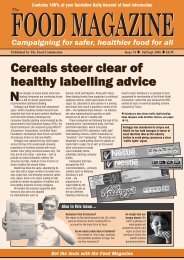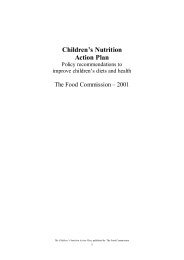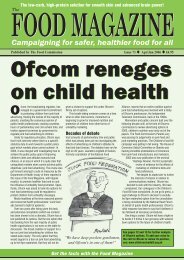Food Magazine - The Food Commission
Food Magazine - The Food Commission
Food Magazine - The Food Commission
You also want an ePaper? Increase the reach of your titles
YUMPU automatically turns print PDFs into web optimized ePapers that Google loves.
farming<br />
“This milk’ll have them all getting broody!”<br />
significant part of the cycle. After calving the<br />
cow is ‘open’ and available for a new<br />
conception, which will usually take place within<br />
three months (a cow’s menstrual cycle is 21<br />
days).<br />
About two months before she gives birth, the<br />
milking is stopped and she is ‘dried off’. Within<br />
days of giving birth the milking routine starts<br />
again. Within three months of giving birth, the<br />
cow is made pregnant again. As the diagram of<br />
the cow’s year shows (below), the cow is<br />
pregnant for about seven out of ten months<br />
lactation, from which we can deduce that at least<br />
two thirds of our milk is extracted from pregnant<br />
cows.<br />
<strong>The</strong> cow’s year<br />
<br />
Open<br />
Milked 10 months<br />
Pregnant 9 months<br />
Dry<br />
In order to maximise yields still further, a farmer<br />
may be tempted to shorten the open period and<br />
the drying off period, so that there are fewer<br />
months when the cow is not lactating. <strong>The</strong> effect<br />
of this would be to increase the proportion of<br />
time that the milk is being collected while the<br />
cow is pregnant.<br />
Taking milk while a cow is pregnant, and<br />
especially during the last few weeks of her<br />
pregnancy, raises questions about hormones in<br />
milk.<br />
During pregnancy, the cow’s ovaries secrete<br />
high levels of progesterone. Her placenta<br />
secretes high levels of oestrogen. <strong>The</strong>se<br />
hormones, plus others, including corticosteroids,<br />
growth hormones and prolactin, target the<br />
mammary gland to stimulate lactation.<br />
<strong>The</strong> figure below shows the hormone cycles<br />
in cattle during a menstrual cycle (around 21<br />
days) followed by pregnancy and calving. <strong>The</strong><br />
curves show blood levels of these hormones,<br />
but milk can be expected to follow the pattern.<br />
Indeed, one of the tests for whether a cow is<br />
pregnant is to examine the progesterone levels in<br />
milk. <strong>The</strong> answer is ‘yes’ if the progesterone<br />
exceeds 10 microgram per litre of milk 1 , which is<br />
typically higher than the blood levels.<br />
New techniques are being explored to reduce<br />
the ‘dry’ period before she gives birth. <strong>The</strong>re are<br />
moves towards using a one-month dry period, 2<br />
and researchers are now demonstrating that a<br />
zero dry period is possible. 3 Yet these last few<br />
weeks of pregnancy are when circulating<br />
hormones can rise to their highest levels.<br />
<strong>The</strong> quantities of hormones in our milk supply<br />
are not equivalent to pharmceutical amounts,<br />
and their absorption from the alimentary tract<br />
may be poor. But there is a surprising lack of<br />
evidence about the possible effects on our health<br />
of consuming cattle hormones in small<br />
quantities, every day for decades. All we know is<br />
that a string of research papers has highlighted<br />
various concerns that appear to be linked to milk<br />
and dairy food consumption (see box).<br />
Infants will be especially vulnerable, partly<br />
because they drink a lot of milk, partly because<br />
they are still growing and may be more<br />
vulnerable to hormonal interference, and partly<br />
because, in the first few months especially, their<br />
gut walls are more permeable to larger<br />
molecules such as hormones.<br />
Milk is a food that is rapidly expanding its<br />
market base as diets in the Eastern and Southern<br />
hemispheres become increasingly westernised.<br />
Its production has become intensified and its<br />
hormone content increased, yet we know next to<br />
nothing about its potential impact on health. And<br />
we haven’t even started to look at the other<br />
components of milk, such as its enzymes,<br />
antibodies or nucleotides.<br />
1) P Rioux, D Rajotte. Progesterone in milk: a<br />
simple experiment illustrating estrous cycle<br />
and enzyme immunoassay. Adv Physiol<br />
Educ 2004, 28:64-67.<br />
2) KC Bachman. Milk production of dairy cows<br />
treated with oestrogen at the onset of a<br />
short dry period. J Dairy Sci 2002, 85:797-<br />
803.<br />
3) Washington State University: Dry Period –<br />
Does the Cow Need One See<br />
http://www.puyallup.wsu.edu/dairy/shortcou<br />
rse/shortcourseArticles.asp<br />
Blood levels of hormones during menstrual cycle and pregnancy of cattle<br />
Source: Virginia State University, Dept Dairy Science.



